StreamVLN 通过在线、多轮对话的方式,输入连续视频,输出动作序列。
通过结合语言指令、视觉观测和空间位姿信息,驱动模型生成导航动作(前进、左转、右转、停止)。
论文地址:StreamVLN: Streaming Vision-and-Language Navigation via SlowFast Context Modeling
代码地址:https://github.com/OpenRobotLab/StreamVLN
本文分享StreamVLN 复现和模型推理的过程~
下面是示例效果:
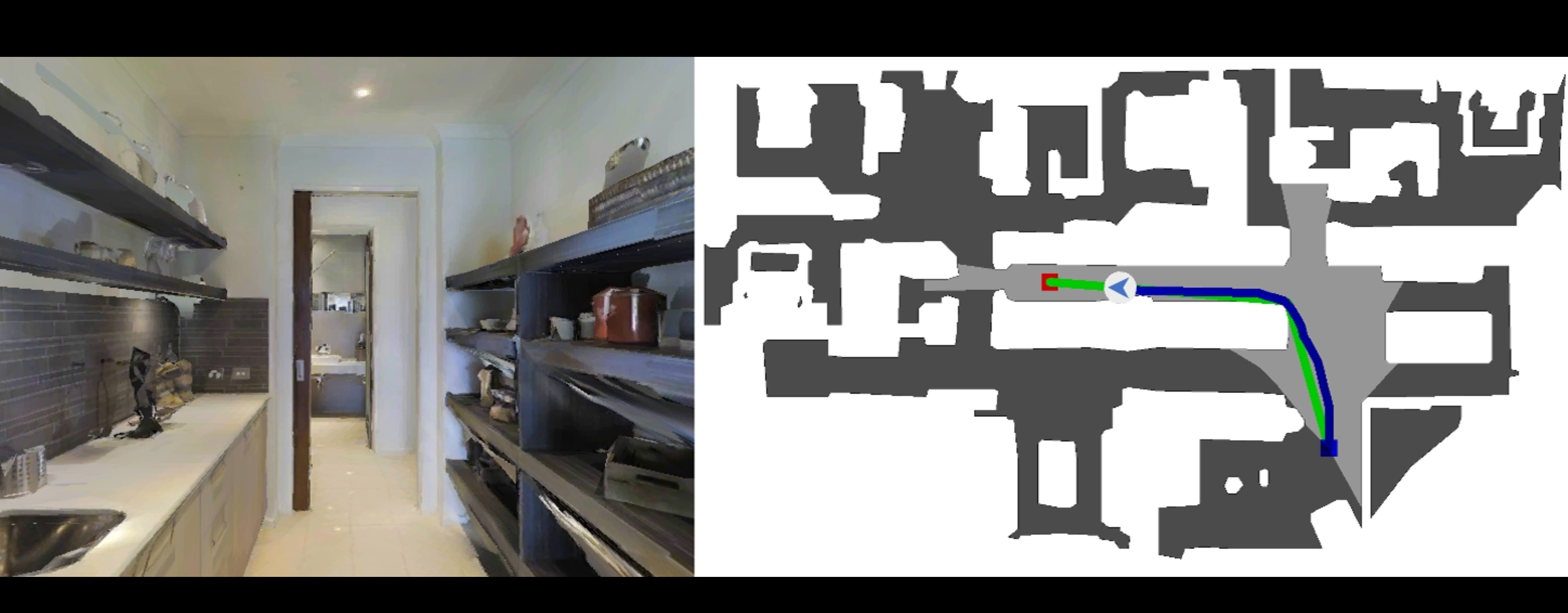
1、创建Conda环境
首先创建一个Conda环境,名字为streamvln,python版本为3.9;
然后进入streamvln环境,执行下面命令:
conda create -n streamvln python=3.9
conda activate streamvln2、 安装habitat仿真环境
先安装 habitat-sim,执行下面命令进行安装
conda install habitat-sim==0.2.4 withbullet headless -c conda-forge -c aihabitat再安装 habitat-lab,
git clone --branch v0.2.4 https://github.com/facebookresearch/habitat-lab.git
cd habitat-lab
pip install -e habitat-lab # install habitat_lab
pip install -e habitat-baselines # install habitat_baselines3、安装第三方的依赖库
获取 StreamVLN 的代码
git clone https://github.com/OpenRobotLab/StreamVLN.git
cd StreamVLN安装其他依赖库:
pip install -r requirements.txt2025/7/23 补丁安装:,需要安装 protobuf==3.20.1
pip install protobuf==3.20.14、准备数据集
需要准备三种类型的数据,新建一个data文件夹来存放:
1)Matterport3D (MP3D) Scenes
快速下载地址:https://cloud.tsinghua.edu.cn/f/03e0ca1430a344efa72b/?dl=1
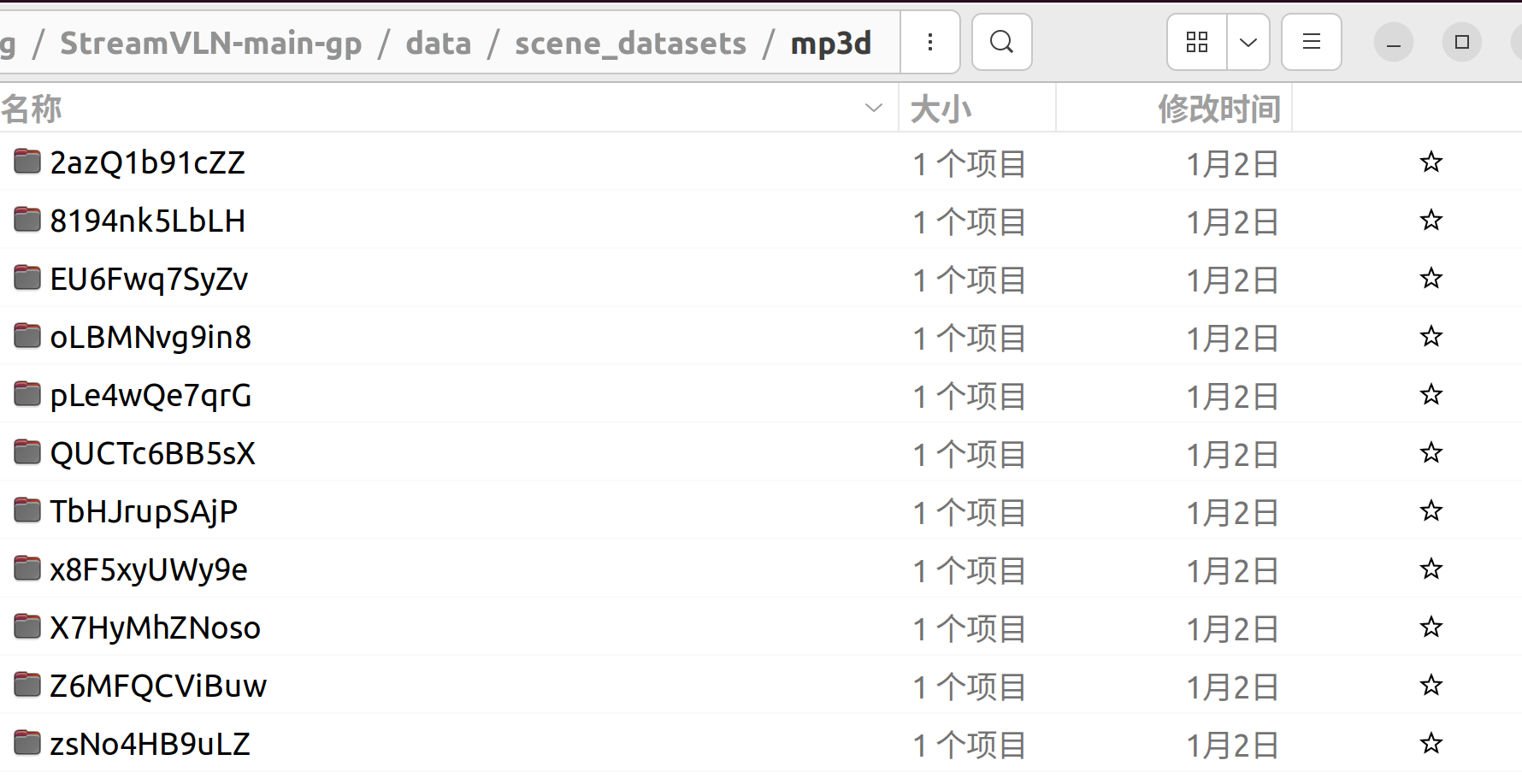
每个文件夹中,包含一个.glb文件:

如果是想要完整MP3D数据,推荐使用“批量下载”方式~(可选)
参考我这篇博客:MatterPort3D 数据集 | 简介 | 多途径下载-CSDN博客
2)VLN-CE Episodes
下载 VLN-CE episodes的链接,然后重命名:
- r2r(重命名 R2R_VLNCE_v1/ -> r2r/)
- rxr(重命名 RxR_VLNCE_v0/ -> rxr/)
- envdrop(重命名 R2R_VLNCE_v1-3_preprocessed/envdrop/ -> envdrop/)
最后,将它们解压到data/datasets/目录中。
3)Collected Trajectory Data
作者提供预先收集的观察-动作轨迹数据用于训练;
这些轨迹是在 Matterport3D 环境下使用R2R和RxR的训练片段收集的。
下载链接:https://huggingface.co/datasets/cywan/StreamVLN-Trajectory-Data/blob/main/README.md
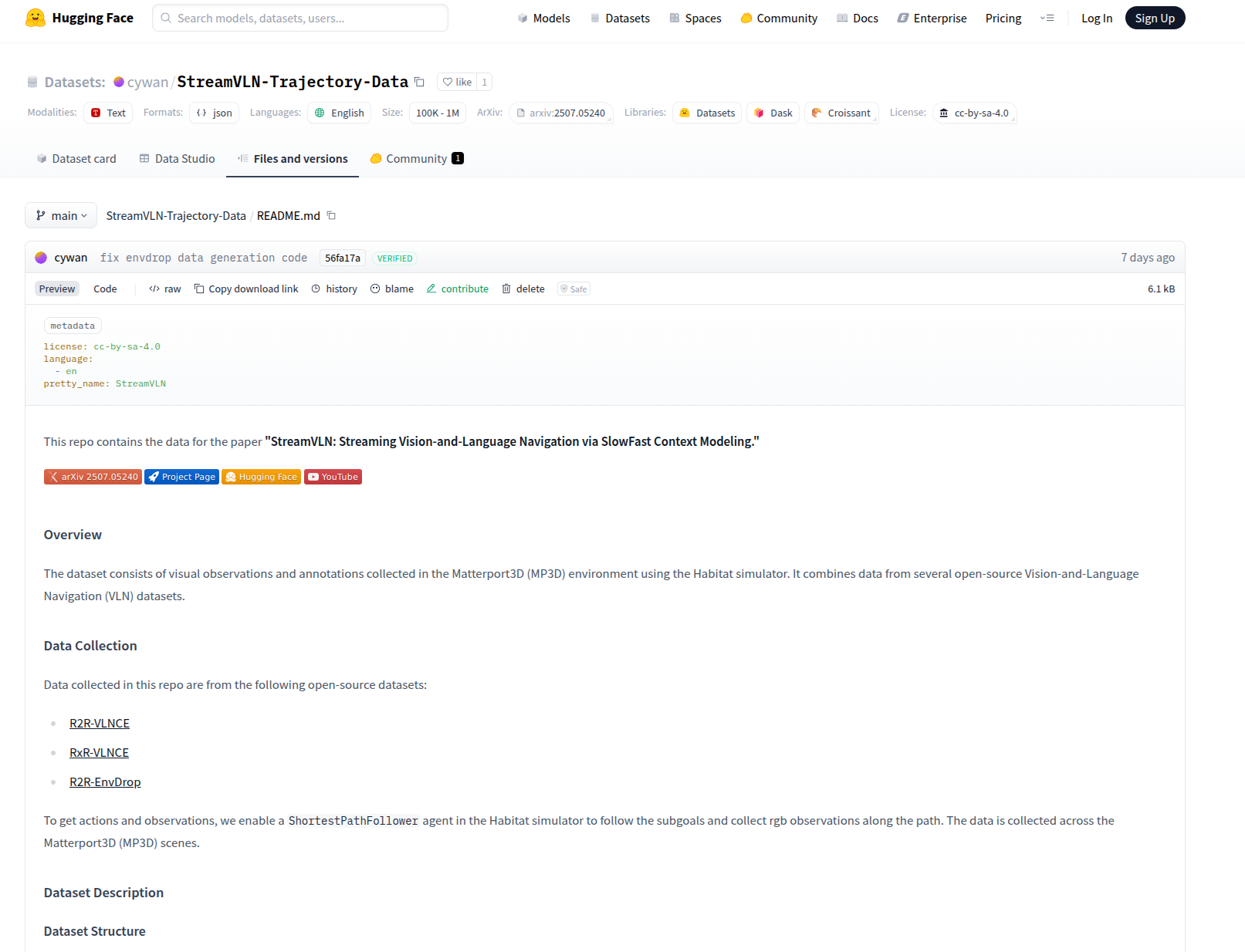
下载好上面三个数据集后,文件夹结构应如下所示:
data/
├── datasets/
│ ├── r2r/
│ │ ├── train/
│ │ ├── val_seen/
│ │ │ └── val_seen.json.gz
│ │ └── val_unseen/
│ │ └── val_unseen.json.gz
│ ├── rxr/
│ │ ├── train/
│ │ ├── val_seen/
│ │ │ ├── val_seen_guide.json.gz
│ │ │ └── ...
│ │ └── val_unseen/
│ │ ├── val_unseen_guide.json.gz
│ │ └── ...
│ └── envdrop/
│ ├── envdrop.json.gz
│ └── ...
│
├── scene_datasets/
│ └── mp3d/
│ ├── 17DRP5sb8fy/
│ ├── 1LXtFkjw3qL/
│ └── ...
└── trajectory_data/
├── R2R/
│ ├── images/
│ └── annotations.json
├── RxR/
│ ├── images/
│ └── annotations.json
└── EnvDrop/
├── images/
└── annotations.json
5、下载模型权重
提供了提供两个模型权重,
模型权重1:基准测试重现(仿真环境)
使用此权重来重现 VLN-CE 基准测试的结果,链接:
https://huggingface.co/mengwei0427/StreamVLN_Video_qwen_1_5_r2r_rxr_envdrop_scalevln
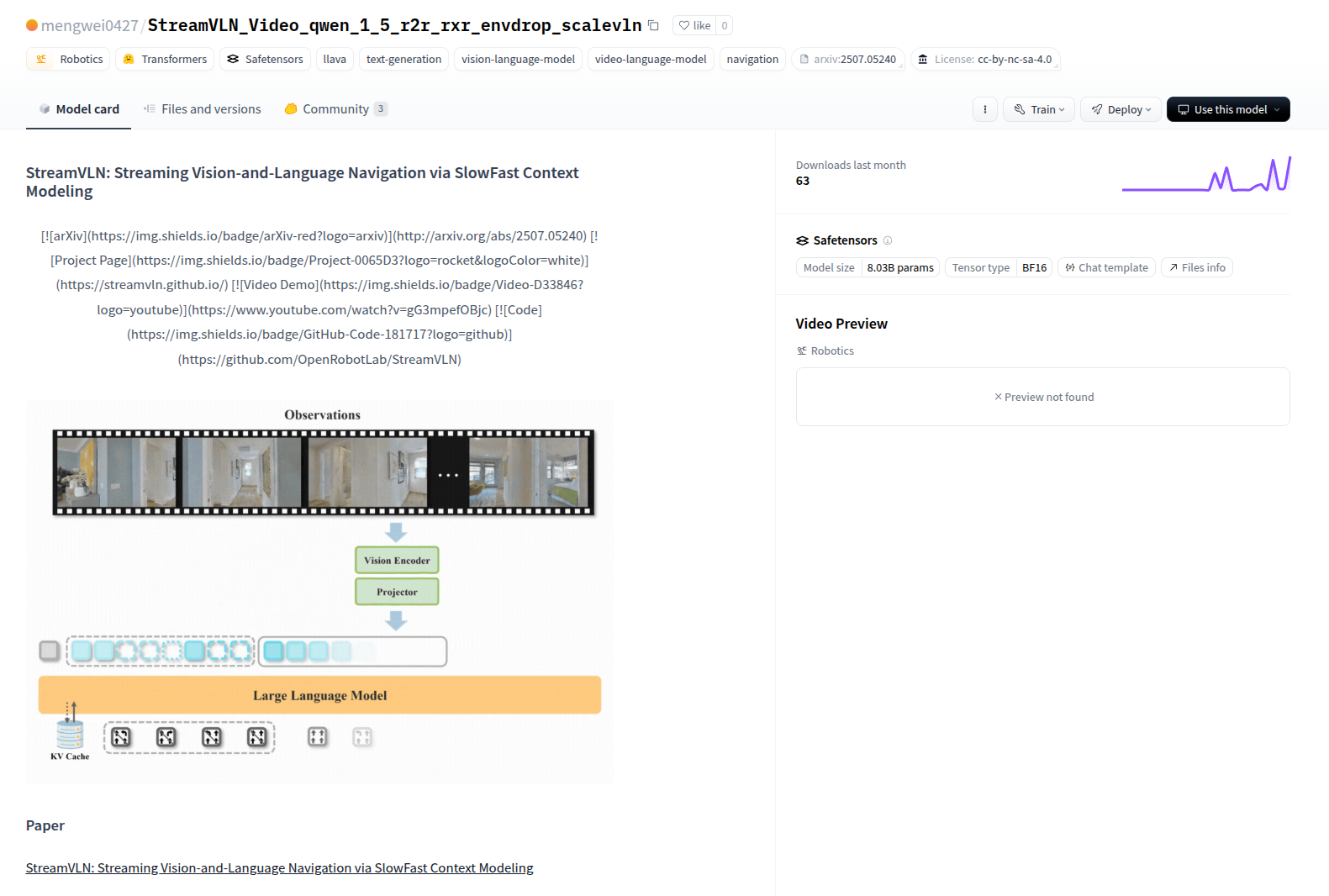
下载好的模型权重,存放在data目录下,比如:
data/StreamVLN_Video_qwen_1_5_r2r_rxr_envdrop_scalevln
模型权重2:真实世界部署
下载链接:https://huggingface.co/mengwei0427/StreamVLN_Video_qwen_1_5_r2r_rxr_envdrop_scalevln_real_world
做了两处修改:
- 删除多余的初始转弯动作:为了更好地对齐指令,删除了指令中未提及的初始左/右转弯。
- 轨迹安全:增强的避障功能可确保在现实环境中更可靠的导航。
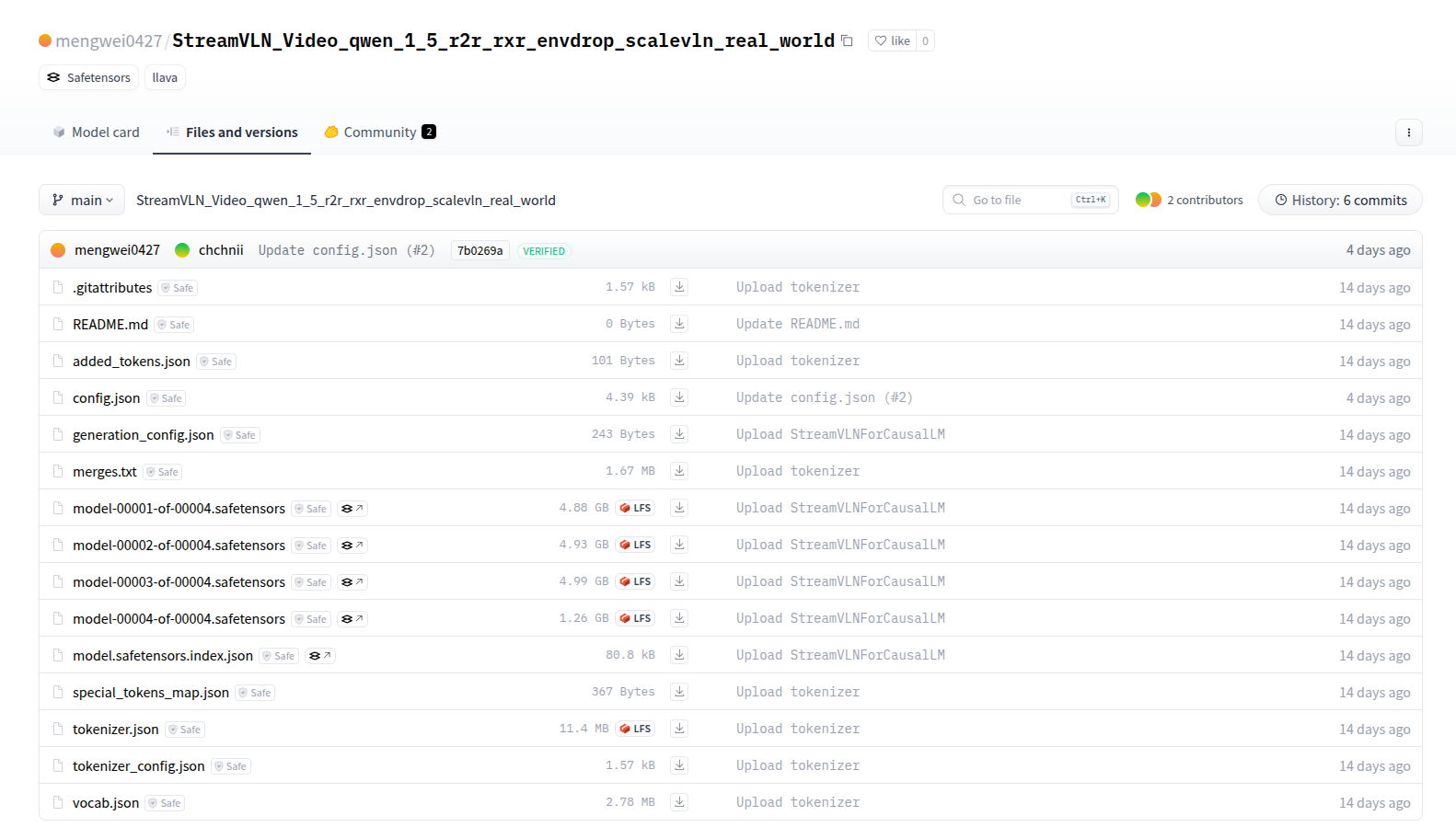
为测试实际场景适用性,在真实环境中用 Unitree Go2 机器狗 部署 StreamVLN:
- 件配置:机器人搭载 Intel RealSense D455 RGB-D 相机采集视觉数据,推理任务部署在远程工作站(配备 RTX 4090 GPU),实现 “机器人采集数据→服务器推理→机器人执行动作” 的闭环。
- 延迟表现:单次推理平均延迟 0.27 秒(生成 4 个动作),室内通信延迟 0.2 秒,室外 1.0 秒,总延迟满足实时导航需求(类似 “机器人看到环境后,能快速计算下一步动作,不会卡顿”)。
6、模型评估推理
修改 StreamVLN-main/scripts/streamvln_eval_multi_gpu.sh
模型权重路径:CHECKPOINT="data/StreamVLN_Video_qwen_1_5_r2r_rxr_envdrop_scalevln"
1)多GPU评估推理
修改 streamvln_eval_multi_gpu.sh 为:
export MAGNUM_LOG=quiet HABITAT_SIM_LOG=quiet
MASTER_PORT=$((RANDOM % 101 + 20000))
CHECKPOINT="data/StreamVLN_Video_qwen_1_5_r2r_rxr_envdrop_scalevln"
echo "CHECKPOINT: ${CHECKPOINT}"
torchrun --nproc_per_node=4 --master_port=$MASTER_PORT streamvln/streamvln_eval.py --model_path $CHECKPOINT
其中的--nproc_per_node=4 ,根据具体的显卡数量来修改
执行命令:
sh scripts/streamvln_eval_multi_gpu.sh打印信息:
CHECKPOINT: data/StreamVLN_Video_qwen_1_5_r2r_rxr_envdrop_scalevln
[2025-07-23 19:02:56,669] torch.distributed.run: [WARNING]
[2025-07-23 19:02:56,669] torch.distributed.run: [WARNING] *****************************************
[2025-07-23 19:02:56,669] torch.distributed.run: [WARNING] Setting OMP_NUM_THREADS environment variable for each process to be 1 in default, to avoid your system being overloaded, please further tune the variable for optimal performance in your application as needed.
[2025-07-23 19:02:56,669] torch.distributed.run: [WARNING] *****************************************
| distributed init (rank 0): env://, gpu 0
| distributed init (rank 1): env://, gpu 1
| distributed init (rank 2): env://, gpu 2
| distributed init (rank 3): env://, gpu 3
Sliding Window Attention is enabled but not implemented for `eager`; unexpected results may be encountered.
Sliding Window Attention is enabled but not implemented for `eager`; unexpected results may be encountered.
Sliding Window Attention is enabled but not implemented for `eager`; unexpected results may be encountered.
Sliding Window Attention is enabled but not implemented for `eager`; unexpected results may be encountered.
[11:03:03.513672] Rank 0: The checkpoint seems to contain `vision_tower` weights: `mm_tunable_parts` contains `mm_vision_tower`.
Loading checkpoint shards: 100%|████████████████████████████████████████████████████████████████████████████████████████████████████████████| 4/4 [00:00<00:00, 5.62it/s]
Loading checkpoint shards: 100%|████████████████████████████████████████████████████████████████████████████████████████████████████████████| 4/4 [00:00<00:00, 5.54it/s]
Loading checkpoint shards: 100%|████████████████████████████████████████████████████████████████████████████████████████████████████████████| 4/4 [00:00<00:00, 5.60it/s]
Loading checkpoint shards: 100%|████████████████████████████████████████████████████████████████████████████████████████████████████████████| 4/4 [00:00<00:00, 5.62it/s]
2025-07-23 19:03:13,045 Initializing dataset R2RVLN-v1
2025-07-23 19:03:13,078 Initializing dataset R2RVLN-v1
[11:03:13.094881] config类型 = <class 'omegaconf.dictconfig.DictConfig'>
2025-07-23 11:03:13,098 initializing sim Sim-v0
[11:03:13.104372] habitat:
seed: 100
env_task: GymHabitatEnv
env_task_gym_dependencies: []...................
显存占用情况:
| 0 N/A N/A 1507162 C+G .../envs/streamvln/bin/python3.9 29085MiB |
| 0 N/A N/A 1507163 G .../envs/streamvln/bin/python3.9 825MiB |
| 0 N/A N/A 1507164 G .../envs/streamvln/bin/python3.9 825MiB |
| 0 N/A N/A 1507165 G .../envs/streamvln/bin/python3.9 825MiB |
| 1 N/A N/A 1507163 C .../envs/streamvln/bin/python3.9 36670MiB |
| 2 N/A N/A 1507164 C .../envs/streamvln/bin/python3.9 36982MiB |
| 3 N/A N/A 1507165 C .../envs/streamvln/bin/python3.9 32280MiB |
+-----------------------------------------------------------------------------------------+
输出结果:
[19:13:20.799677] 32 You are an autonomous navigation assistant. Your task is to Go straight through the doorway.
Go to the left and then left again till you see the star burst pattern on the floor Go through the bedroom doorway and stop when you get to the bed.
Wait there. Devise an action sequence to follow the instruction using the four actions:
TURN LEFT (←) or TURN RIGHT (→) by 15 degrees, MOVE FORWARD (↑) by 25 centimeters, or STOP. These are your historical observations <memory>.[19:13:21.780076] <|im_start|>assistant
↑↑↑→<|im_end|>
[19:13:21.780184] 解析的动作序列 [1, 1, 1, 3]
[19:13:22.859709] <|im_start|>assistant
↑↑↑↑<|im_end|>
[19:13:22.859850] 解析的动作序列 [1, 1, 1, 1]
场景 2azQ1b91cZZ: 22%|█████████████████████████▌ | 14/63 [07:46<27:21, 33.49s/it][11:13:23.935267] <|im_start|>assistant
↑↑←↑<|im_end|>
[19:13:23.935370] 解析的动作序列 [1, 1, 2, 1]
[19:13:25.026463] <|im_start|>assistant
↑→↑STOP<|im_end|>
[19:13:25.026610] 解析的动作序列 [1, 3, 1, 0]
场景 2azQ1b91cZZ: 19%|█████████████████████▉ | 12/63 [07:48<33:42, 39.65s/it][11:13:25.404737]
场景-episode 2azQ1b91cZZ_180 结果:成功=1.0, SPL=0.9987054152599378, Oracle成功=1.0, 到目标距离=0.16980895400047302.......
官方效果-原版代码可视化:
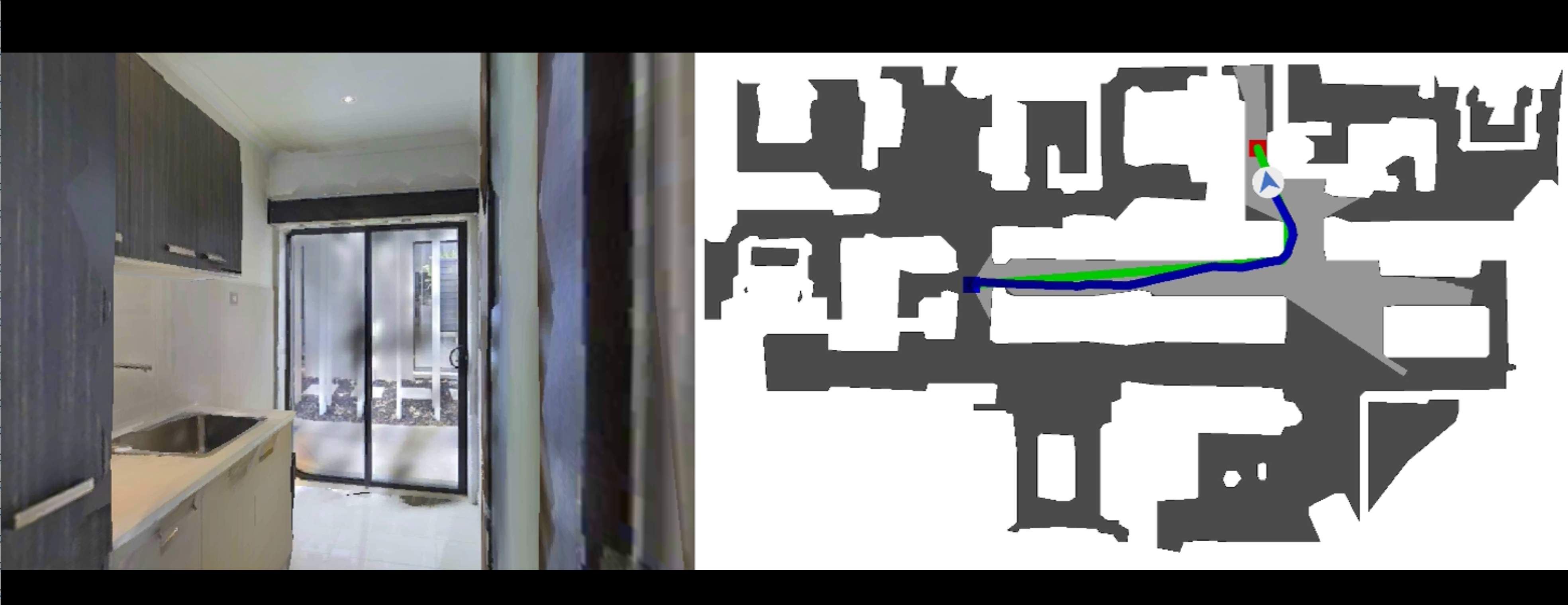
改进版:(streamvln/streamvln_eval.py)
# 导入系统相关库
import sys
import os
# 将上级目录添加到系统路径,便于导入自定义模块
sys.path.insert(0, os.path.abspath(os.path.join(os.path.dirname(__file__), "..")))
# 导入正则表达式、进度条、PyTorch等工具库
import re
import tqdm
import torch
import copy
import json
import random
import argparse
import itertools
import quaternion
import transformers
import numpy as np
# 导入类型注解、配置工具、图像处理等库
from typing import Any
from omegaconf import OmegaConf
from PIL import Image, ImageFile, ImageDraw, ImageFont
from collections import OrderedDict
from torch.nn.utils.rnn import pad_sequence
# 导入深度图像过滤函数
from depth_camera_filtering import filter_depth
from transformers.image_utils import to_numpy_array
# 导入Habitat环境相关库(用于导航模拟)
import habitat
from habitat import logger, Env
from habitat_extensions import measures
from habitat.config.default import get_agent_config
from habitat_baselines.config.default import get_config as get_habitat_config
from habitat.config.default_structured_configs import (
CollisionsMeasurementConfig,
FogOfWarConfig,
TopDownMapMeasurementConfig,
)
from habitat.utils.visualizations import maps
from habitat.utils.visualizations.utils import images_to_video, observations_to_image
# 导入自定义模型和工具函数
from model.stream_video_vln import StreamVLNForCausalLM
from utils.utils import dict_to_cuda
from utils.dist import * # 分布式处理工具
from utils.utils import DEFAULT_IMAGE_TOKEN, IMAGE_TOKEN_INDEX, DEFAULT_MEMORY_TOKEN, MEMORY_TOKEN_INDEX, DEFAULT_VIDEO_TOKEN
class VLNEvaluator:
"""视觉语言导航(VLN)评估器类,用于评估模型在 Habitat 环境中的导航性能"""
def __init__(
self,
config_path: str,
split: str = "val_seen",
env_num: int = 8,
output_path: str = None,
model: Any = None,
tokenizer: Any = None,
epoch: int = 0,
args: argparse.Namespace = None,
):
self.args = args # 命令行参数
self.device = torch.device('cuda') # 使用GPU设备
self.split = split # 评估数据集分割(如val_seen/val_unseen)
self.env_num = env_num # 环境数量
self.save_video = args.save_video # 是否保存导航视频
self.output_path = output_path # 结果输出路径
self.epoch = epoch # 当前训练轮次
self.config_path = config_path # Habitat配置文件路径
self.config = get_habitat_config(config_path) # 加载Habitat配置
self.agent_config = get_agent_config(self.config.habitat.simulator) # 智能体配置
# 获取传感器配置(RGB和深度传感器)
self.sim_sensors_config = self.config.habitat.simulator.agents.main_agent.sim_sensors
# 修改Habitat配置(读写模式)
with habitat.config.read_write(self.config):
self.config.habitat.dataset.split = self.split # 设置数据集分割
# 更新任务测量指标(添加顶视图地图和碰撞检测)
self.config.habitat.task.measurements.update(
{
"top_down_map": TopDownMapMeasurementConfig(
map_padding=3, # 地图填充
map_resolution=1024, # 地图分辨率
draw_source=True, # 绘制起点
draw_border=True, # 绘制边界
draw_shortest_path=True, # 绘制最短路径
draw_view_points=True, # 绘制视角点
draw_goal_positions=True, # 绘制目标位置
draw_goal_aabbs=True, # 绘制目标包围盒
fog_of_war=FogOfWarConfig( # 战争迷雾配置
draw=True,
visibility_dist=5.0, # 可见距离
fov=90, # 视野角
),
),
"collisions": CollisionsMeasurementConfig(), # 碰撞测量配置
}
)
print(f"config类型 = {type(self.config)}")
print(OmegaConf.to_yaml(self.config)) # 打印配置信息
# 提取相机参数
self._camera_height = self.sim_sensors_config.rgb_sensor.position[1] # 相机高度
self._min_depth = self.sim_sensors_config.depth_sensor.min_depth # 最小深度
self._max_depth = self.sim_sensors_config.depth_sensor.max_depth # 最大深度
# 计算相机内参(视场角转弧度,计算fx/fy)
camera_fov_rad = np.deg2rad(self.sim_sensors_config.depth_sensor.hfov)
self._camera_fov = camera_fov_rad
self._fx = self._fy = self.sim_sensors_config.depth_sensor.width / (2 * np.tan(camera_fov_rad / 2))
# 初始化图像处理器、模型和分词器
self.image_processor = model.get_vision_tower().image_processor
self.model = model
self.tokenizer = tokenizer
# 初始化对话提示模板(指导模型生成导航动作)
prompt = f"<video>\nYou are an autonomous navigation assistant. Your task is to <instruction>. Devise an action sequence to follow the instruction using the four actions: TURN LEFT (←) or TURN RIGHT (→) by 15 degrees, MOVE FORWARD (↑) by 25 centimeters, or STOP."
answer = ""
self.conversation = [{"from": "human", "value": prompt}, {"from": "gpt", "value": answer}]
# 动作到索引的映射(STOP/前进/左转/右转)
self.actions2idx = OrderedDict({
'STOP': [0],
"↑": [1],
"←": [2],
"→": [3]
})
# 描述观测的随机前缀(增加输入多样性)
self.conjunctions = [
'you can see ',
'in front of you is ',
'there is ',
'you can spot ',
'you are toward the ',
'ahead of you is ',
'in your sight is '
]
# 模型相关参数(帧数量、未来步骤数、历史记录数)
self.num_frames = args.num_frames
self.num_future_steps = args.num_future_steps
self.num_history = args.num_history
def preprocess_depth_image(self, depth_image, do_depth_scale=True, depth_scale=1000):
"""预处理深度图像:调整尺寸并缩放深度值"""
# 目标尺寸(与RGB图像处理器一致)
target_height = self.image_processor.crop_size['height']
target_width = self.image_processor.crop_size['width']
# 调整深度图像大小(最近邻插值)
resized_depth_image = depth_image.resize((target_width, target_height), Image.NEAREST)
# 转换为数组并缩放(单位转换,如米转毫米)
img = to_numpy_array(resized_depth_image)
if do_depth_scale:
img = img / depth_scale # 缩放深度值
return img, (target_width, target_height)
def get_intrinsic_matrix(self, sensor_cfg) -> np.ndarray:
"""计算相机内参矩阵(针孔相机模型)"""
width = sensor_cfg.width # 图像宽度
height = sensor_cfg.height # 图像高度
fov = sensor_cfg.hfov # 水平视场角
# 计算焦距fx/fy(像素单位)
fx = (width / 2.0) / np.tan(np.deg2rad(fov / 2.0))
fy = fx # 假设正方形像素,fx=fy
# 主点坐标(图像中心)
cx = (width - 1.0) / 2.0
cy = (height - 1.0) / 2.0
# 4x4内参矩阵(齐次坐标)
intrinsic_matrix = np.array([
[fx, 0.0, cx, 0.0],
[ 0.0, fy, cy, 0.0],
[ 0.0, 0.0, 1.0, 0.0],
[ 0.0, 0.0, 0.0, 1.0]
])
return intrinsic_matrix
def preprocess_instrinsic(self, intrinsic, ori_size, target_size):
"""预处理内参矩阵:根据图像尺寸调整(缩放和裁剪)"""
intrinsic = copy.deepcopy(intrinsic)
# 扩展维度(适配批量处理)
if len(intrinsic.shape) == 2:
intrinsic = intrinsic[None, :, :] # 增加批次维度
# 根据图像尺寸缩放内参(宽度和高度方向)
intrinsic[:, 0] /= ori_size[0] / target_size[0] # 宽度方向缩放
intrinsic[:, 1] /= ori_size[1] / target_size[1] # 高度方向缩放
# 处理裁剪变换(调整主点坐标)
intrinsic[:, 0, 2] -= (target_size[0] - target_size[1]) / 2
# 移除多余维度(若批次为1)
if intrinsic.shape[0] == 1:
intrinsic = intrinsic.squeeze(0)
return intrinsic
def get_axis_align_matrix(self):
"""获取轴对齐矩阵(转换 Habitat 坐标系到标准坐标系)"""
# 转换矩阵:Habitat坐标系 -> 标准相机坐标系
ma = torch.tensor([[0, 0, 1, 0], [-1, 0, 0, 0], [0, -1, 0, 0], [0, 0, 0, 1]]).double()
return ma
def xyz_yaw_to_tf_matrix(self, xyz: np.ndarray, yaw: float) -> np.ndarray:
"""将位置(xyz)和偏航角(yaw)转换为4x4变换矩阵"""
x, y, z = xyz
# 旋转+平移矩阵(绕z轴旋转yaw角)
transformation_matrix = np.array(
[
[np.cos(yaw), -np.sin(yaw), 0, x], # 旋转+平移(x)
[np.sin(yaw), np.cos(yaw), 0, y], # 旋转+平移(y)
[0, 0, 1, z], # 平移(z)
[0, 0, 0, 1], # 齐次坐标
]
)
return transformation_matrix
def config_env(self) -> Env:
"""配置并初始化Habitat环境"""
env = Env(config=self.config)
# 可注释掉:仅用于调试单episode
# env.episodes = env.episodes[0:1]
return env
def eval_action(self, idx) -> None:
"""核心评估函数:遍历场景和episode,执行导航并记录指标"""
env = self.config_env() # 初始化环境
# 按场景分组episode(减少场景切换开销)
scene_episode_dict = {}
for episode in env.episodes:
if episode.scene_id not in scene_episode_dict:
scene_episode_dict[episode.scene_id] = []
scene_episode_dict[episode.scene_id].append(episode)
# 获取RGB传感器内参矩阵
intrinsic_matrix = self.get_intrinsic_matrix(self.config.habitat.simulator.agents.main_agent.sim_sensors.rgb_sensor)
# 存储评估指标:成功率、SPL、 oracle成功率、到目标距离
sucs, spls, oss, ones = [], [], [], []
done_res = [] # 已完成的episode记录(避免重复评估)
# 加载已完成的结果(若存在)
if os.path.exists(os.path.join(self.output_path, f'result.json')):
with open(os.path.join(self.output_path, f'result.json'),'r') as f:
for line in f.readlines():
res = json.loads(line)
done_res.append([res["scene_id"], res["episode_id"], res["episode_instruction"]])
if get_rank() == 0: # 主进程记录指标
sucs.append(res['success'])
spls.append(res['spl'])
oss.append(res['os'])
ones.append(res['ne'])
# 遍历每个场景
for scene in sorted(scene_episode_dict.keys()):
episodes = scene_episode_dict[scene]
scene_id = scene.split('/')[-2] # 提取场景ID
print(f"当前场景ID = {scene_id}")
# 进度条:处理当前进程负责的episode(分布式拆分)
process_bar = tqdm.tqdm(range(len(episodes[idx::self.env_num])), desc=f"场景 {scene_id}")
# 遍历当前进程负责的episode
for episode in episodes[idx::self.env_num]:
# 获取导航指令(普通导航为文本,目标导航为物体类别)
episode_instruction = episode.instruction.instruction_text if 'objectnav' not in self.config_path else episode.object_category
print("开始episode:", episode_instruction)
episode_id = episode.episode_id
# 跳过已完成的episode
if [scene_id, episode_id, episode_instruction] in done_res:
continue
# 重置模型状态(针对当前环境)
self.model.reset_for_env(idx)
# 设置当前episode并重置环境
env.current_episode = episode
observations = env.reset()
# 保存初始RGB图像(调试用)
os.makedirs(os.path.join(self.output_path, f'check_sim_{self.epoch}'), exist_ok=True)
Image.fromarray(observations['rgb']).save(os.path.join(self.output_path, f'check_sim_{self.epoch}', f'rgb_{idx}.jpg'))
vis_frames = [] # 可视化帧(用于生成视频)
step_id = 0 # 步数计数器
# 若保存视频,创建目录
if self.save_video:
os.makedirs(os.path.join(self.output_path, f'vis_{self.epoch}', f'{scene_id}_{episode_id}'), exist_ok=True)
# 记录初始高度(用于计算相对高度)
initial_height = env.sim.get_agent_state().position[1]
# 存储序列数据:RGB、深度、位姿、内参、时间ID、动作序列
rgb_list = []
depth_list = []
depth_images_list = []
pose_list = []
intrinsic_list = []
time_ids = []
action_seq = []
past_key_values = None # 模型缓存(用于增量生成)
output_ids = None # 模型输出ID
# 导航循环:直到episode结束
while not env.episode_over:
self.model.eval() # 模型设为评估模式
time_ids.append(step_id) # 记录当前步数
# 获取当前观测
rgb = observations["rgb"] # RGB图像
depth = observations["depth"] # 深度图像
x, y = observations["gps"] # GPS坐标
camera_yaw = observations["compass"][0] # 指南针(偏航角)
# 过滤深度图像(去噪)
depth = filter_depth(depth.reshape(depth.shape[:2]), blur_type=None)
# 深度值映射到[min_depth, max_depth]并转换为毫米
depth = depth * (self._max_depth - self._min_depth) + self._min_depth
depth = depth * 1000
# 获取智能体状态(位置和旋转)
agent_state = env.sim.get_agent_state()
height = agent_state.position[1] - initial_height # 相对初始高度
# 相机位置(GPS坐标转换)
camera_position = np.array([x, -y, self._camera_height + height])
robot_xy = camera_position[:2]
# 相机到位姿坐标系的变换矩阵
tf_camera_to_episodic = self.xyz_yaw_to_tf_matrix(camera_position, camera_yaw)
# 从四元数获取旋转矩阵,构建变换矩阵
rotation = agent_state.rotation
translation = agent_state.position
rotation_matrix = quaternion.as_rotation_matrix(rotation)
transformation_matrix = np.eye(4)
transformation_matrix[:3, :3] = rotation_matrix
transformation_matrix[:3, 3] = translation
# 预处理RGB图像(适配模型输入)
image = Image.fromarray(rgb).convert('RGB')
image_size = image.size
image = self.image_processor.preprocess(images=image, return_tensors='pt')['pixel_values'][0]
# 预处理深度图像
depth_image, resize_shape = self.preprocess_depth_image(Image.fromarray(depth.astype(np.uint16), mode='I;16'), do_depth_scale=True)
# 预处理内参矩阵(适配图像尺寸)
intrinsic = self.preprocess_instrinsic(intrinsic_matrix, image_size, resize_shape)
intrinsic = torch.from_numpy(intrinsic).float()
# 存储当前帧数据
rgb_list.append(image)
depth_list.append(torch.from_numpy(depth_image).float())
pose_list.append(torch.from_numpy(tf_camera_to_episodic) @ self.get_axis_align_matrix())
intrinsic_list.append(intrinsic)
# 导航指令(普通导航为文本,目标导航为物体类别)
episode_instruction = episode.instruction.instruction_text if 'objectnav' not in self.config_path else episode.object_category
# print("## episode_instruction:", episode_instruction)
# 获取当前指标并可视化
info = env.get_metrics()
if info['top_down_map'] is not None:
frame = observations_to_image({'rgb':observations['rgb']}, info) # 生成可视化帧
# vis_frames.append(frame)
frame_pil = Image.fromarray(frame)
draw = ImageDraw.Draw(frame_pil)
img_width, img_height = frame_pil.size
# --------------------------
# 1. 配置文字参数(左侧布局,增大字体)
# --------------------------
# 任务目标文字
task_text = f"## Task: {episode_instruction}"
# 导航结果信息(实时获取当前指标)
metrics = env.get_metrics() # 实时获取当前步骤的指标
result_text = (
f"scene_episode ID: {scene_id}_{episode_id}\n"
# f"success={metrics['success']:.1f}\n"
# f"SPL={metrics['spl']:.1f}\n"
f"oracle_success = {metrics['oracle_success']:.1f}\n"
f"distance_to_goal = {metrics['distance_to_goal']:.2f}"
)
# 合并文本(任务目标 + 导航结果,用空行分隔)
full_text = f"{task_text}\n{result_text}"
# 字体和布局参数
base_font_size = int(img_height * 0.04) # 字体大小:图像高度的4%
margin = int(img_height * 0.015) # 边距
line_spacing = int(base_font_size * 0.3) # 行间距
text_color = (255, 255, 255) # 白色文字
bg_color = (0, 0, 0, 200) # 深色半透明背景(提高可读性)
# 加载字体(优先支持中文)
try:
font = ImageFont.truetype("simhei.ttf", base_font_size)
except:
font = ImageFont.load_default()
# --------------------------
# 2. 自动换行(限制宽度为图片的2/5,左侧布局)
# --------------------------
max_line_width = int(img_width * 0.4) # 宽度不超过图片的2/5
def wrap_text(text, font, max_width):
"""将文本按最大宽度拆分为多行"""
lines = []
current_line = ""
for char in text:
# 处理换行符(保留用户手动换行)
if char == "\n":
lines.append(current_line)
current_line = ""
continue
# 测试当前行宽度
test_line = current_line + char
bbox = draw.textbbox((0, 0), test_line, font=font)
if (bbox[2] - bbox[0]) > max_width:
lines.append(current_line)
current_line = char
else:
current_line = test_line
if current_line:
lines.append(current_line)
return lines
# 拆分文本为多行(保留手动换行)
wrapped_lines = wrap_text(full_text, font, max_line_width)
# --------------------------
# 3. 计算文本区域大小(左侧定位)
# --------------------------
# 单行高度 = 字体大小 + 行间距
line_height = base_font_size + line_spacing
# 总高度 = 行数×单行高度 - 最后一行的行间距
total_text_height = (len(wrapped_lines) * line_height) - line_spacing
# 最大单行宽度(取最长行的宽度)
max_line_width_actual = 0
for line in wrapped_lines:
bbox = draw.textbbox((0, 0), line, font=font)
line_width = bbox[2] - bbox[0]
if line_width > max_line_width_actual:
max_line_width_actual = line_width
# --------------------------
# 4. 绘制左侧背景框
# --------------------------
# 左侧定位:x从margin开始,y从margin开始
bg_x1 = margin
bg_y1 = margin
# 背景框宽度:最大单行宽度 + 2×边距(确保包裹文字)
bg_x2 = bg_x1 + max_line_width_actual + 2 * margin
# 背景框高度:总文本高度 + 2×边距
bg_y2 = bg_y1 + total_text_height + 2 * margin
# 确保背景框不超出图像边界(底部和右侧)
if bg_y2 > img_height - margin:
bg_y2 = img_height - margin # 底部不超过图像边缘
if bg_x2 > img_width * 0.4 + margin: # 右侧不超过2/5宽度
bg_x2 = int(img_width * 0.4) + margin
# 绘制背景框
draw.rectangle([bg_x1, bg_y1, bg_x2, bg_y2], fill=bg_color)
# --------------------------
# 5. 绘制左侧多行文字
# --------------------------
text_x = bg_x1 + margin # 左对齐,留边距
text_y = bg_y1 + margin # 上对齐,留边距
for line in wrapped_lines:
# 确保文字不超出背景框底部
if text_y + base_font_size > bg_y2 - margin:
break # 超出则停止绘制(避免溢出)
draw.text((text_x, text_y), line, font=font, fill=text_color)
text_y += line_height # 下移到下一行
# --------------------------
# 6. 转回numpy数组,添加到帧列表
# --------------------------
frame = np.array(frame_pil)
vis_frames.append(frame)
# 若动作序列为空,调用模型生成动作
if len(action_seq) == 0:
if output_ids is None:
# 初始化对话模板(首次生成)
sources = copy.deepcopy(self.conversation)
# 替换模板中的指令占位符
sources[0]["value"] = sources[0]["value"].replace(' Where should you go next to stay on track?', f' Please devise an action sequence to follow the instruction which may include turning left or right by a certain degree, moving forward by a certain distance or stopping once the task is complete.')
# 若不是第一步,添加历史观测标记
if step_id != 0 :
sources[0]["value"] += f' These are your historical observations {DEFAULT_MEMORY_TOKEN}.'
# 清理模板中的冗余标记
sources[0]["value"] = sources[0]["value"].replace(DEFAULT_VIDEO_TOKEN+'\n', '')
sources[0]["value"] = sources[0]["value"].replace('<instruction>.', episode.instruction.instruction_text)
add_system = True # 添加系统提示
print(step_id, sources[0]["value"]) # 打印输入提示
else:
# 增量生成:复用历史对话
sources = [{"from": "human", "value": ""}, {"from": "gpt", "value": ""}]
add_system = False
# 预处理文本输入(转换为token ID)
input_ids, conversations = self.preprocess_qwen([sources], self.tokenizer, True, add_system=add_system)
# 增量拼接历史输出
if output_ids is not None:
input_ids = torch.cat([output_ids, input_ids.to(output_ids.device)], dim=1)
# 选择输入帧(当前帧+历史帧,根据配置)
images = rgb_list[-1:]
depths = depth_list[-1:]
poses = pose_list[-1:]
intrinsics = intrinsic_list[-1:]
# 若达到指定步数,添加历史帧
if step_id != 0 and step_id % self.num_frames == 0:
if self.num_history is None:
history_ids = slice(0, time_ids[0], self.num_future_steps)
else:
history_ids = slice(0, time_ids[0], (time_ids[0] // self.num_history))
images = rgb_list[history_ids] + images
depths = depth_list[history_ids] + depths
poses = pose_list[history_ids] + poses
intrinsics = intrinsic_list[history_ids] + intrinsics
# 构建模型输入字典(图像、深度、位姿、内参、文本等)
input_dict = {
'images': torch.stack(images).unsqueeze(0),
'depths': torch.stack(depths).unsqueeze(0),
'poses': torch.stack(poses).unsqueeze(0),
'intrinsics': torch.stack(intrinsics).unsqueeze(0),
'inputs': input_ids,
'env_id': idx,
'time_ids': [time_ids],
'task_type': [0]
}
# 输入转移到GPU
input_dict = dict_to_cuda(input_dict, self.device)
# 转换为bfloat16精度(加速推理)
for key, value in input_dict.items():
if key in ['images', 'depths', 'poses', 'intrinsics']:
input_dict[key] = input_dict[key].to(torch.bfloat16)
# 模型生成动作序列
outputs = self.model.generate(
**input_dict,
do_sample=False, # 确定性生成
num_beams=1, # beam search大小
max_new_tokens=10000, # 最大生成token数
use_cache=True, # 使用缓存加速
return_dict_in_generate=True,
past_key_values=past_key_values # 复用历史缓存
)
# 更新输出和缓存
output_ids = outputs.sequences
past_key_values = outputs.past_key_values
# 解码生成结果
llm_outputs = self.tokenizer.batch_decode(output_ids, skip_special_tokens=False)[0].strip()
print(llm_outputs, flush=True) # 打印模型输出
# 解析动作序列
action_seq = self.parse_actions(llm_outputs)
print('解析的动作序列', action_seq, flush=True)
# 若未解析到动作,默认停止
if len(action_seq) == 0:
action_seq = [0]
# 执行下一个动作
action = action_seq.pop(0)
observations = env.step(action) # 环境执行动作并返回新观测
step_id += 1 # 步数+1
# 每num_frames步重置模型状态(避免缓存过大)
if step_id % self.num_frames == 0:
self.model.reset_for_env(idx)
output_ids = None
past_key_values = None
time_ids = []
process_bar.update(1) # 更新进度条
# 获取当前episode的评估指标
metrics = env.get_metrics()
# 保存视频(若配置)
if self.save_video:
images_to_video(
vis_frames,
os.path.join(self.output_path, f'vis_{self.epoch}'),
f'{scene_id}_{episode_id}',
fps=6,
quality=9
)
vis_frames.clear() # 清空可视化帧
# 记录指标
sucs.append(metrics['success'])
spls.append(metrics['spl'])
oss.append(metrics['oracle_success'])
ones.append(metrics['distance_to_goal'])
print(f"场景-episode {scene_id}_{episode_id} 结果:成功={metrics['success']}, SPL={metrics['spl']}, Oracle成功={metrics['oracle_success']}, 到目标距离={metrics['distance_to_goal']}")
# 保存当前episode结果
result = {
"scene_id": scene_id,
"episode_id": episode_id,
"success": metrics["success"],
"spl": metrics["spl"],
"os": metrics['oracle_success'],
"ne": metrics["distance_to_goal"],
"steps": step_id,
"episode_instruction": episode_instruction
}
with open(os.path.join(self.output_path, f'result.json'), 'a') as f:
f.write(json.dumps(result) + "\n")
env.close() # 关闭环境
# 返回当前进程的指标(转换为tensor便于分布式汇总)
return (torch.tensor(sucs).to(self.device),
torch.tensor(spls).to(self.device),
torch.tensor(oss).to(self.device),
torch.tensor(ones).to(self.device),
torch.tensor(len(sucs)).to(self.device))
def parse_actions(self, output):
"""解析模型输出文本,提取动作序列"""
# 构建动作匹配模式(正则表达式)
action_patterns = '|'.join(re.escape(action) for action in self.actions2idx)
regex = re.compile(action_patterns)
matches = regex.findall(output) # 匹配动作
# 转换为动作索引
actions = [self.actions2idx[match] for match in matches]
actions = itertools.chain.from_iterable(actions) # 展平列表
return list(actions)
def preprocess_qwen(self, sources, tokenizer: transformers.PreTrainedTokenizer, has_image: bool = False, max_len=2048, system_message: str = "You are a helpful assistant.", add_system: bool = False):
"""预处理Qwen模型的输入文本:转换为token并添加图像/记忆标记"""
# 角色映射(human->user, gpt->assistant)
roles = {"human": "user", "gpt": "assistant"}
# 深拷贝分词器,避免修改原对象
tokenizer = copy.deepcopy(tokenizer)
# 添加图像和记忆特殊token
if has_image:
tokenizer.add_tokens(["<image>"], special_tokens=True)
tokenizer.add_tokens(["<memory>"], special_tokens=True)
# 获取特殊token的ID
image_token_index = tokenizer.convert_tokens_to_ids("<image>")
memory_token_index = tokenizer.convert_tokens_to_ids("<memory>")
im_start, im_end = tokenizer.additional_special_tokens_ids
# 无需mask的token索引
unmask_tokens_idx = [198, im_start, im_end]
nl_tokens = tokenizer("\n").input_ids # 换行符的token
# 重置Qwen的对话模板(避免重复添加系统提示)
chat_template = "{% for message in messages %}{{'<|im_start|>' + message['role'] + '\n' + message['content'] + '<|im_end|>' + '\n'}}{% endfor %}{% if add_generation_prompt %}{{ '<|im_start|>assistant\n' }}{% endif %}"
tokenizer.chat_template = chat_template
# 处理输入文本,转换为模型可接受的格式
conversations = []
input_ids = []
for i, source in enumerate(sources):
# 随机选择前缀,拼接图像标记
prompt = random.choice(self.conjunctions) + DEFAULT_IMAGE_TOKEN
# 更新用户输入(添加图像提示)
if len(source[0]["value"]) != 0:
source[0]["value"] += f" {prompt}."
else:
source[0]["value"] = f"{prompt}."
# 跳过非人类的起始对话
if roles[source[0]["from"]] != roles["human"]:
source = source[1:]
input_id = [] # 存储token ID
# 添加系统提示(若需要)
if add_system:
input_id += tokenizer.apply_chat_template([{"role" : "system", "content" : system_message}])
# 处理对话内容
for conv in source:
# 兼容不同格式的对话数据
try:
role = conv["role"]
content = conv["content"]
except:
role = conv["from"]
content = conv["value"]
role = roles.get(role, role) # 映射角色
conv = [{"role" : role, "content" : content}]
conversations.append(content) # 记录对话内容
# 应用对话模板,转换为token ID
encode_id = tokenizer.apply_chat_template(conv)
input_id += encode_id
# 替换图像和记忆token为模型指定ID
for idx, encode_id in enumerate(input_id):
if encode_id == image_token_index:
input_id[idx] = IMAGE_TOKEN_INDEX
if encode_id == memory_token_index:
input_id[idx] = MEMORY_TOKEN_INDEX
input_ids.append(input_id)
# 转换为tensor
input_ids = torch.tensor(input_ids, dtype=torch.long)
return input_ids, conversations # 返回token ID和对话内容
def pad_tensors(tensors, lens=None, max_len=None, pad=0):
"""对齐张量列表(填充到最大长度)"""
if lens is None:
lens = [t.size(0) for t in tensors]
if len(lens) == 1 and lens[0] == max_len:
return tensors
if max_len is None:
max_len = max(lens)
bs = len(tensors)
hid = tensors[0].shape[1:] # 隐藏维度
dtype = tensors[0].dtype
# 初始化填充后的张量
output = torch.zeros(bs, max_len, *hid, dtype=dtype).to(tensors[0].device)
if pad:
output.data.fill_(pad) # 填充值
# 复制数据到填充后的张量
for i, (t, l) in enumerate(zip(tensors, lens)):
output.data[i, :l, ...] = t.data
return output
def eval():
"""主函数:解析参数,初始化模型和评估器,执行评估"""
global local_rank
# 解析命令行参数
parser = argparse.ArgumentParser()
parser.add_argument("--local_rank", default=0, type=int, help="本地进程排名")
parser.add_argument("--model_path", type=str, default="", help="模型路径")
parser.add_argument("--habitat_config_path", type=str, default='config/vln_r2r.yaml', help="Habitat配置文件路径")
parser.add_argument("--eval_split", type=str, default='val_unseen', help="评估数据集分割")
parser.add_argument("--output_path", type=str, default='./results/val_unseen/streamvln', help="结果输出路径")
parser.add_argument("--num_future_steps", type=int, default=4, help="未来步骤数")
parser.add_argument("--num_frames", type=int, default=32, help="每批处理的帧数")
parser.add_argument("--save_video", default=True, help="是否保存导航视频")
parser.add_argument("--num_history", type=int, default=8, help="历史帧数")
parser.add_argument("--model_max_length", type=int, default=4096, help="模型最大序列长度")
# 分布式相关参数
parser.add_argument('--world_size', default=1, type=int, help='分布式进程数')
parser.add_argument('--rank', default=0, type=int, help='进程排名')
parser.add_argument('--gpu', default=0, type=int, help='GPU设备ID')
parser.add_argument('--port', default='1111', help='分布式通信端口')
parser.add_argument('--dist_url', default='env://', help='分布式通信URL')
parser.add_argument('--device', default='cuda', help='设备类型')
args = parser.parse_args()
# 初始化分布式模式
init_distributed_mode(args)
local_rank = args.local_rank
# 加载分词器
tokenizer = transformers.AutoTokenizer.from_pretrained(
args.model_path,
model_max_length=args.model_max_length,
padding_side="right"
)
# 加载模型配置和模型
config = transformers.AutoConfig.from_pretrained(args.model_path)
model = StreamVLNForCausalLM.from_pretrained(
args.model_path,
attn_implementation="eager", # 禁用 FlashAttention2
# attn_implementation="flash_attention_2", # 使用FlashAttention加速
torch_dtype=torch.bfloat16, # 使用bfloat16精度
config=config,
low_cpu_mem_usage=False,
)
model.model.num_history = args.num_history # 设置历史帧数
model.requires_grad_(False) # 冻结模型参数
model.to(local_rank) # 移动模型到指定设备
# 执行评估
evaluate(model, tokenizer, args)
def evaluate(model, tokenizer, args):
"""执行评估:初始化评估器,分布式收集结果并汇总"""
model.eval() # 模型设为评估模式
world_size = get_world_size() # 分布式进程数
model.reset(world_size) # 重置模型(分布式适配)
# 初始化评估器
evaluator = VLNEvaluator(
config_path=args.habitat_config_path,
split=args.eval_split,
env_num=world_size,
output_path=args.output_path,
model=model,
tokenizer=tokenizer,
epoch=0,
args=args
)
# 执行评估,获取当前进程的指标
sucs, spls, oss, ones, ep_num = evaluator.eval_action(get_rank())
# 分布式汇总结果
ep_num_all = [torch.zeros_like(ep_num) for _ in range(world_size)]
dist.all_gather(ep_num_all, ep_num) # 收集各进程的episode数量
# 初始化存储所有进程的指标
sucs_all = [torch.zeros(ep_num_all[i], dtype=sucs.dtype).to(sucs.device) for i in range(world_size)]
spls_all = [torch.zeros(ep_num_all[i], dtype=spls.dtype).to(spls.device) for i in range(world_size)]
oss_all = [torch.zeros(ep_num_all[i], dtype=oss.dtype).to(oss.device) for i in range(world_size)]
ones_all = [torch.zeros(ep_num_all[i], dtype=ones.dtype).to(ones.device) for i in range(world_size)]
dist.barrier() # 同步所有进程
# 收集所有进程的指标
dist.all_gather(sucs_all, sucs)
dist.all_gather(spls_all, spls)
dist.all_gather(oss_all, oss)
dist.all_gather(ones_all, ones)
dist.barrier() # 同步所有进程
# 合并所有进程的结果
sucs_all = torch.cat(sucs_all, dim=0)
spls_all = torch.cat(spls_all, dim=0)
oss_all = torch.cat(oss_all, dim=0)
ones_all = torch.cat(ones_all, dim=0)
# 计算总体指标
result_all = {
"平均成功率": (sum(sucs_all)/len(sucs_all)).item(),
"平均SPL": (sum(spls_all)/len(spls_all)).item(),
"平均Oracle成功率": (sum(oss_all)/len(oss_all)).item(),
"平均到目标距离": (sum(ones_all)/len(ones_all)).item(),
"总episode数": len(sucs_all)
}
print(result_all) # 打印总体结果
# 主进程保存总体结果
if get_rank() == 0:
with open(os.path.join(args.output_path, f'result.json'), 'a') as f:
f.write(json.dumps(result_all))
if __name__ == "__main__":
eval() # 启动评估
可视化效果(实时显示任务、是否成功、到目标的距离)
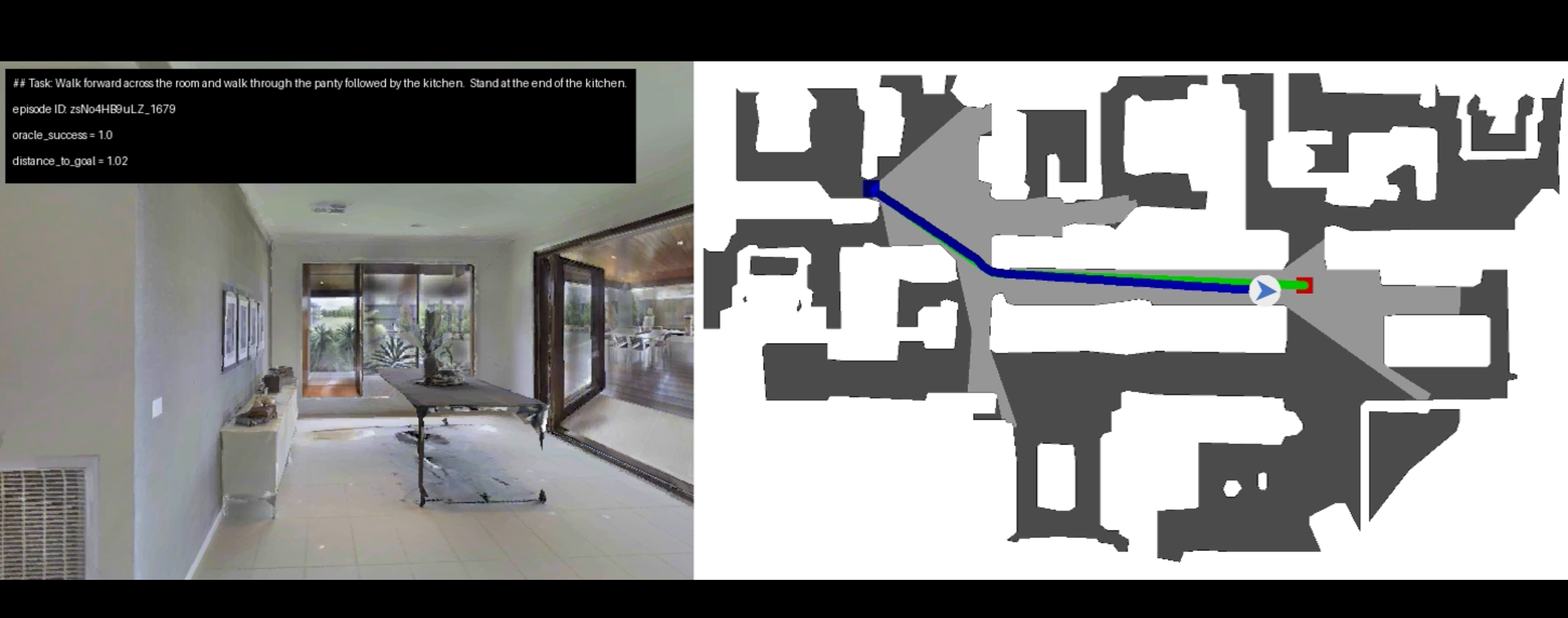
2)单GPU评估推理
执行命令:(num_frames设置小一些,默认32需要较大显存)
python streamvln/streamvln_eval.py --model_path "data/StreamVLN_Video_qwen_1_5_r2r_rxr_envdrop_scalevln" --num_frames 8打印信息:
(streamvln) lgp@lgp-MS-7E07:~/2025_project/StreamVLN-main$
(streamvln) lgp@lgp-MS-7E07:~/2025_project/StreamVLN-main$ python streamvln/streamvln_eval.py --model_path "data/StreamVLN_Video_qwen_1_5_r2r_rxr_envdrop_scalevln"
Not using distributed mode
Sliding Window Attention is enabled but not implemented for `eager`; unexpected results may be encountered.
[19:45:30.773156] The checkpoint seems to contain `vision_tower` weights: `mm_tunable_parts` contains `mm_vision_tower`.
config.json: 576B [00:00, 60.4kB/s]
model.safetensors: 32%|██████████████████ | 1.14G/3.51G [05:15<16:04, 2.47MB/s]
model.safetensors: 100%|████████████████████████████████████████████████████████| 3.51G/3.51G [08:42<00:00, 6.73MB/s]
Loading checkpoint shards: 100%|███████████████████████████████████████████████████████| 4/4 [00:00<00:00, 9.20it/s]
............
7、模型训练
使用分布式设置,执行多节点多 GPU 训练,运行指令:
sbatch scripts/streamvln_train_slurm.sh分享完成~